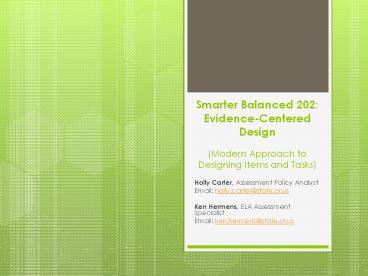Smarter Balanced 202: Evidence-Centered Design (Modern Approach to Designing Items and Tasks)
Title:
Smarter Balanced 202: Evidence-Centered Design (Modern Approach to Designing Items and Tasks)
Description:
... oxymoron, hyperbole, paradox) or connotative meanings of words and phrases used in context and the impact of these word choices on meaning and tone. –
Number of Views:160
Avg rating:3.0/5.0
Title: Smarter Balanced 202: Evidence-Centered Design (Modern Approach to Designing Items and Tasks)
1
Smarter Balanced 202 Evidence-Centered Design
(Modern Approach to Designing Items and Tasks)
- Holly Carter, Assessment Policy Analyst
- Email holly.carter_at_state.or.us
- Ken Hermens, ELA Assessment Specialist
- Email ken.hermens_at_state.or.us
2
Introduction to Evidence-Centered Design (Modern
Approach to Designing Items and Tasks)
- Traditional Item Development
Evidence-Centered Design
Versus
3
Traditional Approach to Item Development
1.2.1 Apply reference skills to determine word
meanings. 1.2.2 Apply vocabulary strategies in
grade level text. 1.3.1 Understand and apply new
vocabulary. 1.3.2 Understand and apply
content/academic vocabulary. 1.4.1 Know common
sight words appropriate to grade-level. 1.4.2 Appl
y fluency to enhance comprehension. 1.4.3 Apply
different reading rates to match
text. 2.1.1 Understand how to use questioning
when reading. 2.1.2 Understand how to create
mental imagery. 2.1.3 Understand and determine
important or main ideas and important details in
text. 2.1.4 Apply comprehension monitoring
strategies before, during, and after reading
use prior knowledge/schema. 2.1.5 Apply
comprehension monitoring strategies before,
during, and after reading predict and
infer. 2.1.6 Apply comprehension monitoring
strategies before, during, and after reading
monitor for meaning, create mental
images. 2.1.7 Apply comprehension monitoring
strategies during and after reading summarize
informational/expository text and
literary/narrative text.
4
Traditional Approach to Item Development
1.2.1 Apply reference skills to determine word
meanings. 1.2.2 Apply vocabulary strategies in
grade level text. 1.3.1 Understand and apply new
vocabulary. 1.3.2 Understand and apply
content/academic vocabulary. 1.4.1 Know common
sight words appropriate to grade-level. 1.4.2 Appl
y fluency to enhance comprehension. 1.4.3 Apply
different reading rates to match
text. 2.1.1 Understand how to use questioning
when reading. 2.1.2 Understand how to create
mental imagery. 2.1.3 Understand and determine
important or main ideas and important details in
text. 2.1.4 Apply comprehension monitoring
strategies before, during, and after reading
use prior knowledge/schema. 2.1.5 Apply
comprehension monitoring strategies before,
during, and after reading predict and
infer. 2.1.6 Apply comprehension monitoring
strategies before, during, and after reading
monitor for meaning, create mental
images. 2.1.7 Apply comprehension monitoring
strategies during and after reading summarize
informational/expository text and
literary/narrative text.
5
Traditional Approach to Item Development
1.2.2 1.3.2 2.1.3 2.1.5 2.1.7
6
Traditional Approach to Item Development
Content Standard 2.2.3 Perform addition
accurately for single and two digit numbers.
Item Beth says that 2 4 6. Explain why
Beth is correct.
7
(No Transcript)
8
Applying Evidence-Centered Design to Item and
Task Development
Beth says that 2 4 6. Explain why Beth is
correct.
9
Applying Evidence-Centered Design to Item and
Task Development
2 4 ____
10
Applying Evidence-Centered Design toItem and
Task Development
Beth says that 2 4 6. Explain why Beth is
correct.
2 4 ____
11
6 Key Concepts of Evidence-Centered Design
12
Example of a Claim
English Language Arts Literacy Claim 1 Students
can read closely and analytically to comprehend a
range of increasingly complex literary and
informational texts.
13
6 Key Concepts of Evidence-Centered Design
14
Example of an Assessment Target
Grade 11 Assessment Target Analyze the
figurative (e.g., euphemism, oxymoron, hyperbole,
paradox) or connotative meanings of words and
phrases used in context and the impact of these
word choices on meaning and tone.
15
6 Key Concepts of Evidence-Centered Design
16
Example of an Evidence Description
Evidence for Assessment Target 1 When reading
informational or argumentative texts, students
analyze the figurative or implied meanings of
words or phrases as they are used in a text and
analyze how the choice of these particular words
affects meaning and tone.
17
6 Key Concepts of Evidence-Centered Design
18
Example of a Task Model
Task Model 1 A constructed response for which
the student is prompted to identify an example of
figurative language, explain the meaning, and
describe how it affects meaning and tone.
Stimulus text should be on grade level.
19
6 Key Concepts of Evidence-Centered Design
6. Develop Items or Performance Tasks
20
Building a Logical Argument
Common Core State Standards
Claim
Assessment Target
Evidence
Student Response
21
6 Key Components of Evidence-Centered Design
6. Develop Items or Performance Tasks
22
Examining an ItemThrough the Lens of
Evidence-Centered Design
Evidence Student can create visual
representations of fractions that range from
one-half to four-fifths.
Task Model Partition tool is used to divide a
given quadrilateral into up to 20 equal sections
and to highlight fractions of the quadrilateral
that represent halves, thirds, quarters, or
fifths.
23
Using Evidence-Centered Design to Guide Item
Design
- What evidence is required given the assessment
target I am measuring? - What are the key features that must be included
in the item? - Will this item allow for the production of the
evidenceI am seeking? - Is there anything about this item that may make
it more difficult to collect evidence from some
students?
24
(No Transcript)
25
Resources
- Smarter Balanced Website
- http//www.smarterbalanced.org/
- Smarter Sample Items and Performance Tasks
- http//www.smarterbalanced.org/smarterbalance
d-assessments/item - Smarter Item Writing and Review Materials
- http//www.smarterbalanced.org/smarter-balanced-as
sessments/item-writing-and-review/ - Common Core State Standards Toolkit
- http//www.ode.state.or.us/search/page/?id3430
- Common Core State Standards Assessment Resources
- http//www.ode.state.or.us/search/page/?id3298
26
Next Smarter Balanced Webinar
- Smarter Balanced 203
- CCSS Across the Curriculum
- March 5, 2013 (330-430 p.m.)
- ELA Items and Performance Tasks that have
Science and Social Sciences context - Instructional gaps between CCSS and current
Oregon Math and ELA Standards - http//www.ode.state.or.us/news/events/.
27
Thank you!
- Please send additional input, questions, or
anecdotes to - Rachel Aazzerah (Math/Smarter Balanced Pilot
Test) Rachel.Aazzerah_at_state.or.us - Derek Brown (Essential Skills)
- Derek.Brown_at_state.or.us
- Holly Carter (SBAC Accessibility/Accommodations)
- Holly.Carter_at_state.or.us
- Mark Freed (Math)
- Mark.Freed_at_state.or.us
- Ken Hermens (English/Language Arts)
- Ken.Hermens_at_state.or.us































